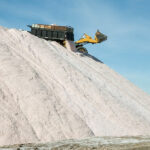What Rocks Are Magnetic? Magnetic rocks, primarily those containing magnetite, are valuable for landscape design, and you can explore captivating ideas at rockscapes.net. These rocks not only add visual interest but also offer unique properties for homeowners, landscape designers, architects, gardeners, DIY enthusiasts, and suppliers across the USA, especially in regions like Arizona. Discover how to choose, install, and maintain these magnetic wonders to elevate your outdoor spaces.
1. What Makes Rocks Magnetic?
The primary reason some rocks exhibit magnetic properties lies in their mineral composition, particularly the presence of iron-rich minerals such as magnetite. Magnetism arises from the arrangement and behavior of electrons within these minerals.
- Mineral Composition: The presence of minerals like magnetite (Fe3O4) is the key factor. Magnetite is an iron oxide and one of the most magnetic minerals found in nature.
- Electron Arrangement: Magnetism in minerals is caused by the alignment of electron spins. In magnetite, the iron ions (Fe2+ and Fe3+) are arranged in a specific crystal structure that allows for strong magnetic alignment.
- Magnetic Domains: Within a magnetic mineral, there are small regions called magnetic domains. In a non-magnetized state, these domains are randomly oriented, canceling out the overall magnetic effect. When an external magnetic field is applied, these domains align, causing the rock to become magnetized.
- Types of Magnetism:
- Ferromagnetism: Exhibited by minerals like magnetite, where strong alignment of electron spins results in a strong magnetic field.
- Ferrimagnetism: Occurs when magnetic moments of ions in a crystal structure are aligned anti-parallel but have unequal magnitudes, resulting in a net magnetic moment. Magnetite is a prime example of a ferrimagnetic mineral.
Rocks become magnetic due to the presence and specific arrangement of iron-rich minerals like magnetite, where the alignment of electron spins within magnetic domains creates a noticeable magnetic field.
2. Which Rocks Commonly Exhibit Magnetic Properties?
Several types of rocks can exhibit magnetic properties due to the presence of magnetic minerals. Here are some of the most common ones:
- Magnetite-rich Rocks: Rocks with a high concentration of magnetite are the most likely to be magnetic. Magnetite is an iron oxide mineral (Fe3O4) known for its strong magnetism.
- Igneous Rocks: Some igneous rocks, formed from cooled magma or lava, contain magnetite. Examples include:
- Basalt: A dark, fine-grained volcanic rock that can contain small grains of magnetite.
- Gabbro: A coarse-grained intrusive igneous rock, similar to basalt but formed deep within the Earth.
- Kimberlite: A rare, mantle-derived igneous rock, sometimes containing magnetite along with diamonds.
- Metamorphic Rocks: Metamorphism, the alteration of existing rocks by heat and pressure, can create magnetic minerals. Examples include:
- Iron Formations: Banded iron formations (BIFs) are sedimentary rocks metamorphosed and rich in iron oxides, including magnetite.
- Skarn: A metamorphic rock formed at the contact between igneous intrusions and carbonate rocks, often containing magnetite.
- Sedimentary Rocks: While less common, some sedimentary rocks can contain magnetic minerals:
- Black Sands: These sands contain concentrations of heavy minerals, including magnetite, often found along beaches or in riverbeds.
- Placer Deposits: Sedimentary deposits where heavy minerals, including magnetite, accumulate due to their density.
